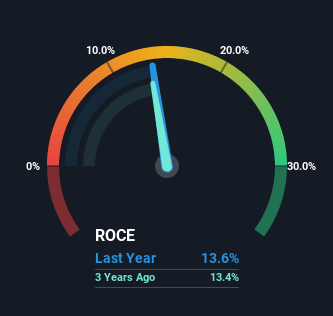- United States
- /
- Healthcare Services
- /
- NasdaqGS:HSIC
Be Wary Of Henry Schein (NASDAQ:HSIC) And Its Returns On Capital

Finding a business that has the potential to grow substantially is not easy, but it is possible if we look at a few key financial metrics. Firstly, we'd want to identify a growing return on capital employed (ROCE) and then alongside that, an ever-increasing base of capital employed. Basically this means that a company has profitable initiatives that it can continue to reinvest in, which is a trait of a compounding machine. However, after investigating Henry Schein (NASDAQ:HSIC), we don't think it's current trends fit the mold of a multi-bagger.
What is Return On Capital Employed (ROCE)?
Just to clarify if you're unsure, ROCE is a metric for evaluating how much pre-tax income (in percentage terms) a company earns on the capital invested in its business. Analysts use this formula to calculate it for Henry Schein:
Return on Capital Employed = Earnings Before Interest and Tax (EBIT) ÷ (Total Assets - Current Liabilities)
0.14 = US$859m ÷ (US$8.4b - US$2.1b) (Based on the trailing twelve months to March 2022).
Therefore, Henry Schein has an ROCE of 14%. On its own, that's a standard return, however it's much better than the 10% generated by the Healthcare industry.
Check out our latest analysis for Henry Schein

Above you can see how the current ROCE for Henry Schein compares to its prior returns on capital, but there's only so much you can tell from the past. If you're interested, you can view the analysts predictions in our free report on analyst forecasts for the company.
So How Is Henry Schein's ROCE Trending?
When we looked at the ROCE trend at Henry Schein, we didn't gain much confidence. Around five years ago the returns on capital were 18%, but since then they've fallen to 14%. Although, given both revenue and the amount of assets employed in the business have increased, it could suggest the company is investing in growth, and the extra capital has led to a short-term reduction in ROCE. If these investments prove successful, this can bode very well for long term stock performance.
The Bottom Line
In summary, despite lower returns in the short term, we're encouraged to see that Henry Schein is reinvesting for growth and has higher sales as a result. In light of this, the stock has only gained 8.9% over the last five years. Therefore we'd recommend looking further into this stock to confirm if it has the makings of a good investment.
On a separate note, we've found 1 warning sign for Henry Schein you'll probably want to know about.
While Henry Schein isn't earning the highest return, check out this free list of companies that are earning high returns on equity with solid balance sheets.
Valuation is complex, but we're here to simplify it.
Discover if Henry Schein might be undervalued or overvalued with our detailed analysis, featuring fair value estimates, potential risks, dividends, insider trades, and its financial condition.
Access Free AnalysisHave feedback on this article? Concerned about the content? Get in touch with us directly. Alternatively, email editorial-team (at) simplywallst.com.
This article by Simply Wall St is general in nature. We provide commentary based on historical data and analyst forecasts only using an unbiased methodology and our articles are not intended to be financial advice. It does not constitute a recommendation to buy or sell any stock, and does not take account of your objectives, or your financial situation. We aim to bring you long-term focused analysis driven by fundamental data. Note that our analysis may not factor in the latest price-sensitive company announcements or qualitative material. Simply Wall St has no position in any stocks mentioned.
About NasdaqGS:HSIC
Henry Schein
Provides health care products and services to office-based dental and medical practitioners, and alternate sites of care worldwide.
Good value with adequate balance sheet.
Similar Companies
Market Insights
Community Narratives



